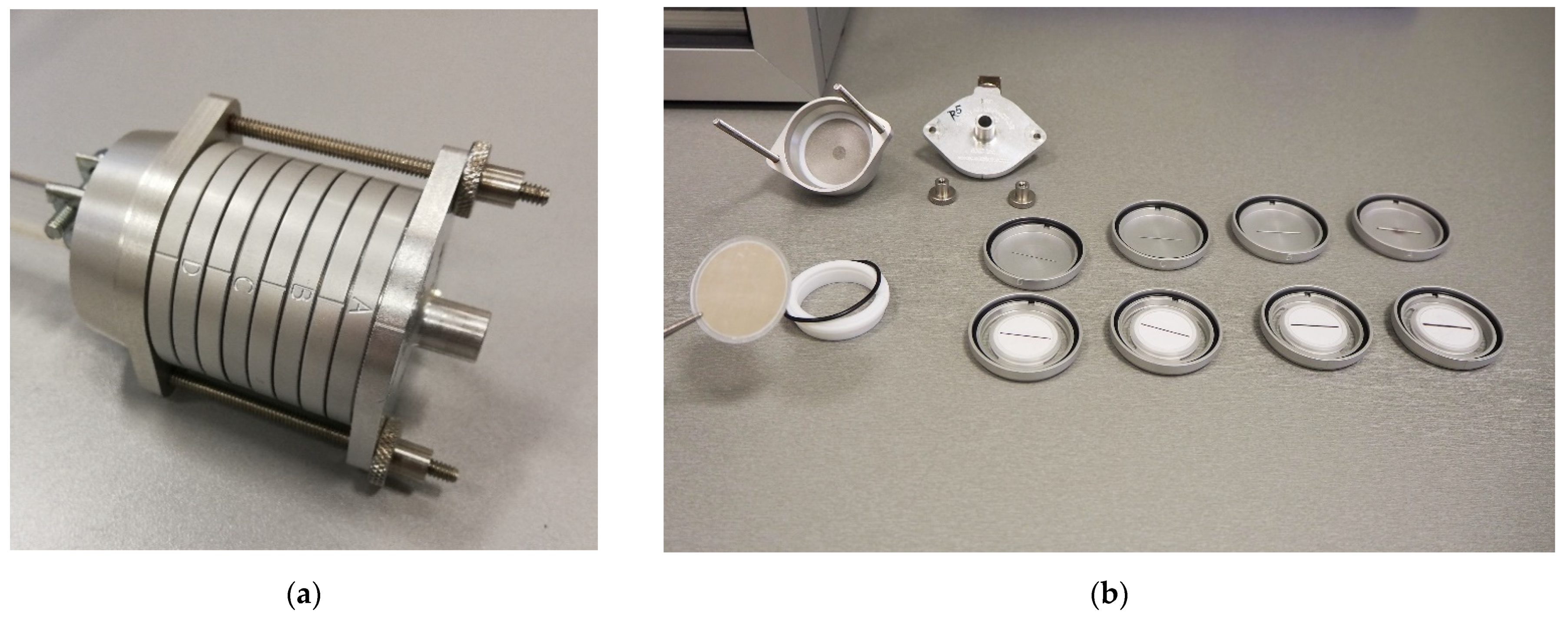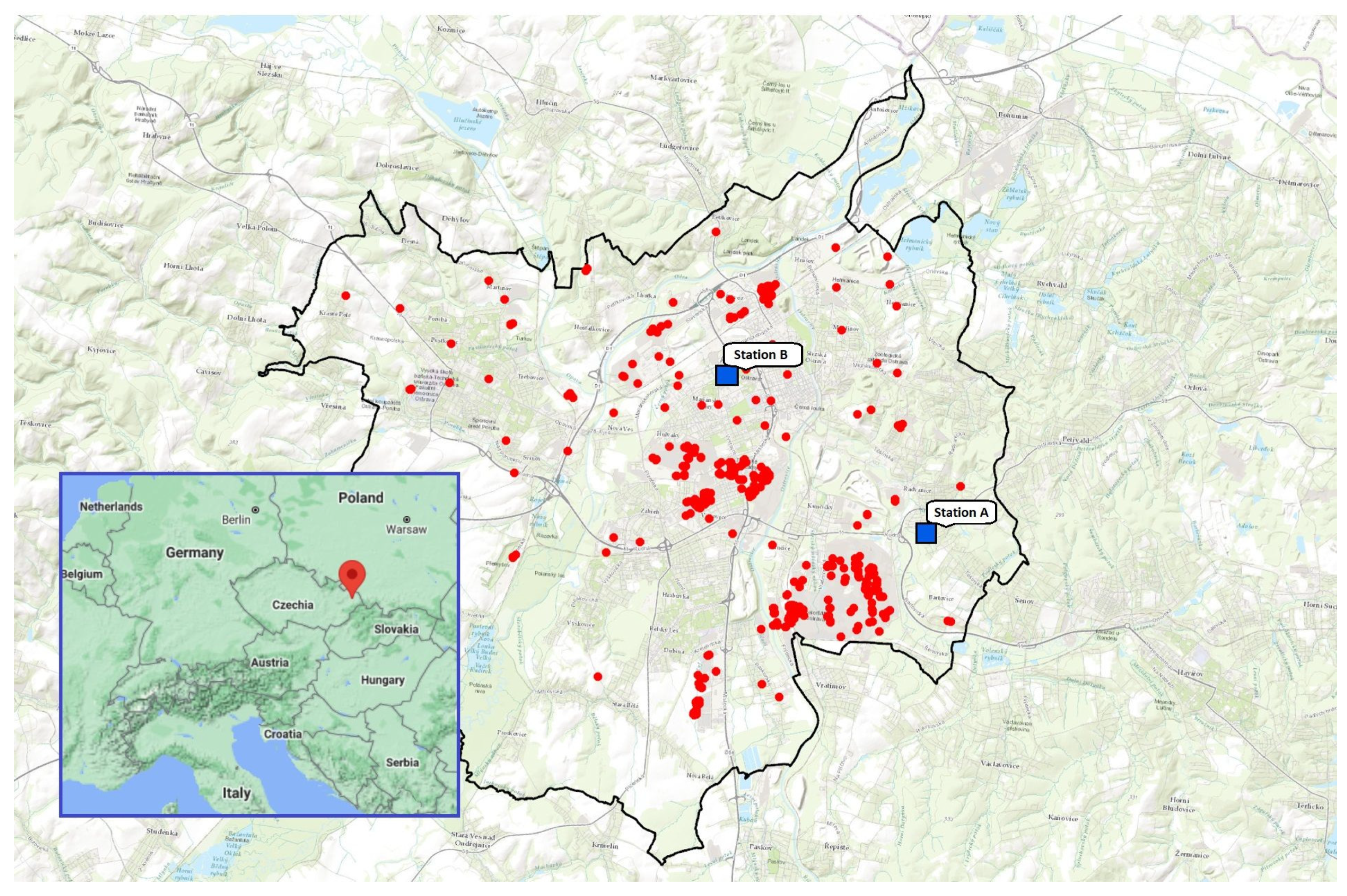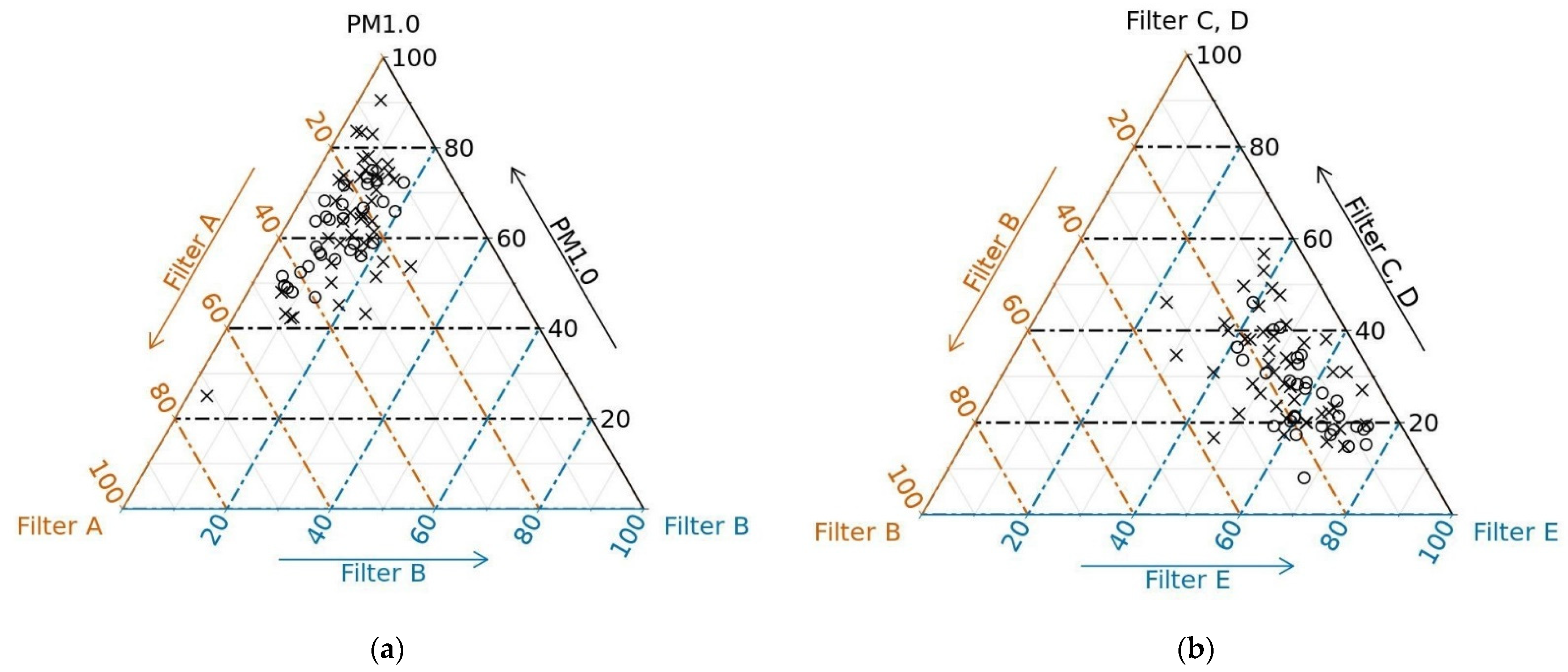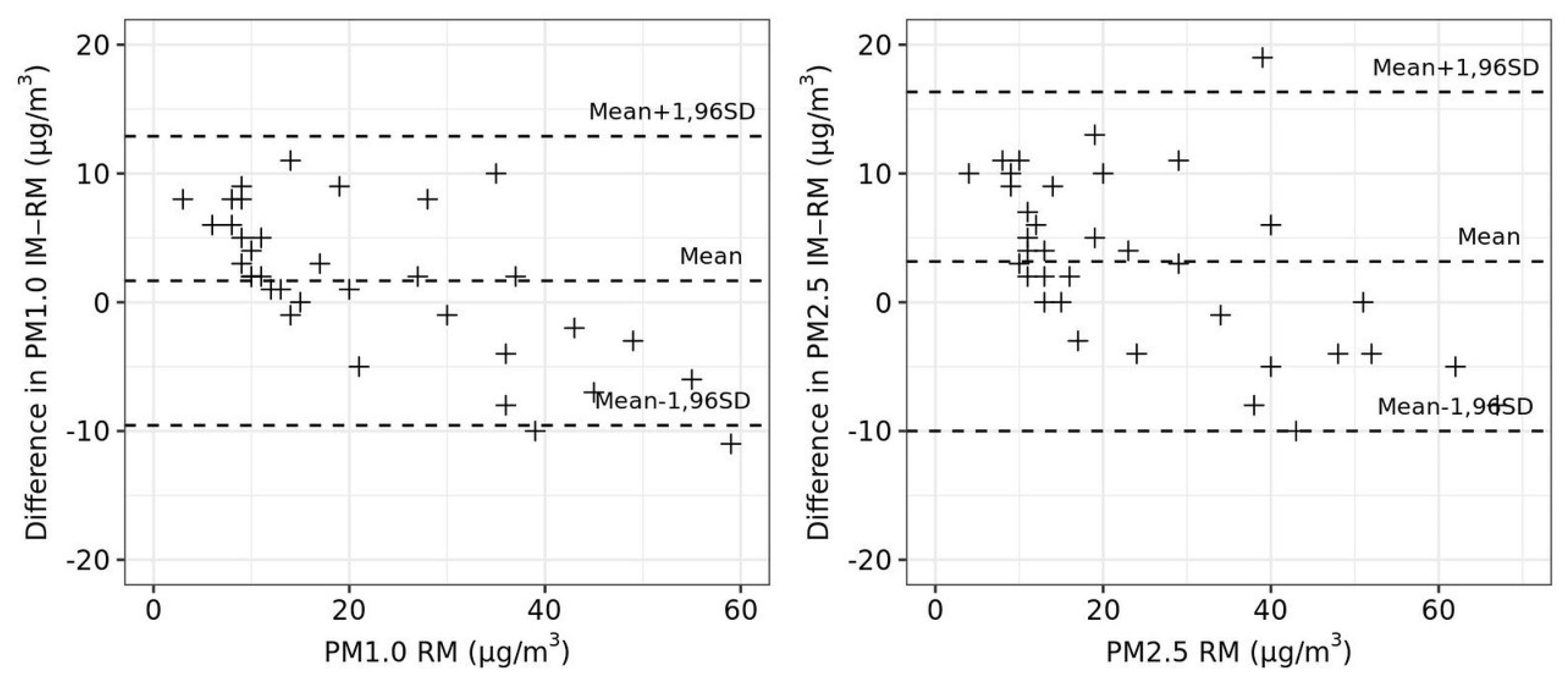Evaluation of Fine and Ultrafine Particles Proportion in Airborne Dust in an Industrial Area
Abstract
:1. Introduction
2. Materials and Methods
2.1. Material
2.2. Location of Sampling
2.3. Procedure for Determining the Proportion of Individual Fractions
2.4. Procedure for Determining the Parameters of the Impactor Measurement
IM Method Accuracy Estimation
2.5. Statistical Analysis
3. Results
3.1. Filter Fraction Analysis
3.2. Determination of IM Method Parameters
3.2.1. Accuracy Estimation
3.2.2. Precision, Expanded Uncertainty and Detection Limit
4. Discussion
5. Conclusions
Author Contributions
Funding
Institutional Review Board Statement
Informed Consent Statement
Data Availability Statement
Acknowledgments
Conflicts of Interest
References
- Air Quality—Particle Size Fraction Definitions for Health-Related Sampling; (ISO Standard No. 7708:1995); International Organization for Standardization: Geneva, Switzerland, 1995; Available online: https://www.iso.org/standard/14534.html (accessed on 17 May 2021).
- World Health Organization. Review of Evidence on Health Aspects of Air Pollution—REVIHAAP Project: Technical Report; WHO Regional Office for Europe: Copenhagen, Denmark, 2016; Available online: https://www.ncbi.nlm.nih.gov/books/NBK361805/ (accessed on 17 May 2021).
- Ohlwein, S.; Kappeler, R.; Joss, M.K.; Künzli, N.; Hoffmann, B. Health effects of ultrafine particles: A systematic literature review update of epidemiological evidence. Int. J. Public Health 2019, 64, 547–559. [Google Scholar] [CrossRef]
- Chen, H.; Kwong, J.C.; Copes, R.; Hystad, P.; van Donkelaar, A.; Tu, K.; Brook, J.R.; Goldberg, M.S.; Martin, R.V.; Murray, B.J.; et al. Exposure to ambient air pollution and the incidence of dementia: A population-based cohort study. Environ. Int. 2017, 108, 271–277. [Google Scholar] [CrossRef]
- Peters, R.; Ee, N.; Peters, J.; Booth, A.; Mudway, I.; Anstey, K.J. Air Pollution and Dementia: A Systematic Review. J. Alzheimer’s Dis. 2019, 70, S145–S163. [Google Scholar] [CrossRef] [PubMed] [Green Version]
- Health Effects Institute. Understanding the Health Effects of Ambient Ultrafine Particles; Health Effects Institute: Boston, MA, USA, 2013; Available online: https://www.healtheffects.org/system/files/Perspectives3.pdf (accessed on 17 May 2021).
- Utell, M.J.; Frampton, M.W. Acute Health Effects of Ambient Air Pollution: The Ultrafine Particle Hypothesis. J. Aerosol Med. 2000, 13, 355–359. [Google Scholar] [CrossRef] [PubMed]
- Nel, A.; Xia, T.; Mädler, L.; Li, N. Toxic potential of materials at the nanolevel. Science 2006, 311, 622–627. [Google Scholar] [CrossRef] [PubMed] [Green Version]
- Valavanidis, A.; Fiotakis, K.; Vlachogianni, T. Airborne Particulate Matter and Human Health: Toxicological Assessment and Importance of Size and Composition of Particles for Oxidative Damage and Carcinogenic Mechanisms. J. Environ. Sci. Heal. Part C 2008, 26, 339–362. [Google Scholar] [CrossRef] [PubMed]
- Alfaro-Moreno, E.; Garcia-Cuellar, C.; De-Vizcaya-Ruiz, A.; Rojas-Bracho, L.; Osornio-Vargas, A. Cellular Mechanisms behind Particulate Matter Air Pollution–Related Health Effects. In Air Pollution; CRC Press: Boca Raton, FL, USA, 2010; pp. 249–274. [Google Scholar]
- European Environment Agency. Air quality in Europe—2019 report; Publications Office of the European Union: Luxemburg, Luxemburg, 2019; Available online: https://www.eea.europa.eu/publications/air-quality-in-europe-2019 (accessed on 17 May 2021).
- Jirik, V.; Machaczka, O.; Miturová, H.; Tomasek, I.; Slachtova, H.; Janoutova, J.; Velicka, H.; Janout, V. Air Pollution and Potential Health Risk in Ostrava Region—A Review. Cent. Eur. J. Public Health 2016, 24, S4–S17. [Google Scholar] [CrossRef] [Green Version]
- Tronville, P.; Rivers, R. Developing parameters for multi-mode ambient air models including the nanometer mode. J. Phys. Conf. Ser. 2017, 838, 012036. [Google Scholar] [CrossRef] [Green Version]
- Mainka, A.; Zajusz-Zubek, E. PM1 in Ambient and Indoor Air—Urban and Rural Areas in the Upper Silesian Region, Poland. Atmosphere 2019, 10, 662. [Google Scholar] [CrossRef] [Green Version]
- Giorio, C.; Tapparo, A.; Scapellato, M.L.; Carrieri, M.; Apostoli, P.; Bartolucci, G.B. Field comparison of a personal cascade impactor sampler, an optical particle counter and CEN-EU standard methods for PM10, PM2.5 and PM1 measurement in urban environment. J. Aerosol Sci. 2013, 65, 111–120. [Google Scholar] [CrossRef]
- Thuy, N.T.T.; Dung, N.T.; Sekiguchi, K.; Thuy, L.B.; Hien, N.T.T.; Yamaguchi, R. Mass Concentrations and Carbonaceous Compositions of PM0.1, PM2.5, and PM10 at Urban Locations of Hanoi, Vietnam. Aerosol Air Qual. Res. 2018, 18, 1591–1605. [Google Scholar] [CrossRef] [Green Version]
- Workplace Atmospheres—Size Fraction Definitions for Measurement of Airborne Particles; (EN Standard No. 481:1993); European Committee for Standardization: Brussels, Belgium, 1993; Available online: https://standards.cen.eu/dyn/www/f?p=204:110:0::::FSP_PROJECT,FSP_ORG_ID:4733,6119&cs=16545B98167A04A1ABA6364EC140AB024 (accessed on 17 May 2021).
- Workplace Exposure—Terminology; (EN Standard No. 1540:2011); European Committee for Standardization: Brussels, Belgium, 2011; Available online: https://shop.bsigroup.com/products/workplace-exposure-terminology?pid=000000000030217889 (accessed on 17 May 2021).
- Air Quality—Sampling Conventions for Airborne Particle Deposition in the Human Respiratory System; (ISO Standard No. 13138:2012); International Organization for Standardization: Geneva, Switzerland, 2012; Available online: https://www.iso.org/standard/53331.html (accessed on 17 May 2021).
- Sources of pollution in 2019: District: Ostrava-město. Czech Hydrometeorological Institute: EMIS/Zdroje znečišťování za rok 2019: Okres: Ostrava-město. Český hydrometeorologický ústav: EMIS. Available online: https://www.chmi.cz/files/portal/docs/uoco/web_generator/plants/ostrava_mesto_CZ.html (accessed on 10 August 2021).
- General Requirements for the Competence of Testing and Calibration Laboratories; (ISO/IEC Standard No. 17025:2017); International Organization for Standardization/International Electrotechnical Commission: Geneva, Switzerland, 2017; Available online: https://www.iso.org/standard/66912.html (accessed on 17 May 2021).
- Reimann, C.; Filzmoser, P.; Fabian, K.; Hron, K.; Birke, M.; Demetriades, A.; Dinelli, E.; Ladenberger, A. The concept of compositional data analysis in practice—Total major element concentrations in agricultural and grazing land soils of Europe. Sci. Total Environ. 2012, 426, 196–210. [Google Scholar] [CrossRef]
- Aitchison, J. The one-hour course in compositional data analysis or compositional data analysis is easy. In Proceedings of the Third Annual Conference of the International Association for Mathematical Geology, Barcelona, Spain, 22–27 September 1997; pp. 3–35. [Google Scholar]
- Ambient Air—Standard Gravimetric Measurement Method for The Determination of the PM10 or PM2.5 Mass Concentration of Suspended Particulate Matter; (EN Standard No. 12341:2014); European Committee for Standardization: Brussels, Belgium, 2014; Available online: https://www.en-standard.eu/csn-en-12341-ambient-air-standard-gravimetric-measurement-method-for-the-determination-of-the-pm10-or-pm2-5-mass-concentration-of-suspended-particulate-matter/ (accessed on 17 May 2021).
- Salvador, P.; Almeida, S.M.; Cardoso, J.; Almeida-Silva, M.; Nunes, T.; Cerqueira, M.; Alves, C.; Reis, M.A.; Chaves, P.C.; Artíñano, B.; et al. Composition and origin of PM 10 in Cape Verde: Characterization of long-range transport episodes. Atmos. Environ. 2016, 127, 326–339. [Google Scholar] [CrossRef]
- Li, Y.; Zheng, C.; Ma, Z.; Quan, W. Acute and Cumulative Effects of Haze Fine Particles on Mortality and the Seasonal Characteristics in Beijing, China, 2005–2013: A Time-Stratified Case-Crossover Study. Int. J. Environ. Res. Public Health 2019, 16, 2383. [Google Scholar] [CrossRef] [PubMed] [Green Version]
- Meng, X.; Wu, Y.; Pan, Z.; Wang, H.; Yin, G.; Zhao, H. Seasonal Characteristics and Particle-size Distributions of Particulate Air Pollutants in Urumqi. Int. J. Environ. Res. Public Health 2019, 16, 396. [Google Scholar] [CrossRef] [PubMed] [Green Version]
- Wang, K.; Wang, W.; Li, L.; Li, J.; Wei, L.; Chi, W.; Hong, L.; Zhao, Q.; Jiang, J. Seasonal concentration distribution of PM1.0 and PM2.5 and a risk assessment of bound trace metals in Harbin, China: Effect of the species distribution of heavy metals and heat supply. Sci. Rep. 2020, 10, 8160. [Google Scholar] [CrossRef] [PubMed]
- Kelly, F.J.; Fussell, J.C. Size, source and chemical composition as determinants of toxicity attributable to ambient particulate matter. Atmos. Environ. 2012, 60, 504–526. [Google Scholar] [CrossRef]
- Oberdörster, G.; Oberdörster, E.; Oberdörster, J. Nanotoxicology: An Emerging Discipline Evolving from Studies of Ultrafine Particles. Environ. Health Perspect. 2005, 113, 823–839. [Google Scholar] [CrossRef]
- Binkova, B.; Topinka, J.; Sram, R.J.; Sevastyanova, O.; Novakova, Z.; Schmuczerova, J.; Kalina, I.; Popov, T.; Farmer, P.B. In vitro genotoxicity of PAH mixtures and organic extract from urban air particles. Mutat. Res. Mol. Mech. Mutagen. 2007, 620, 114–122. [Google Scholar] [CrossRef]
- Lewtas, J. Air pollution combustion emissions: Characterization of causative agents and mechanisms associated with cancer, reproductive, and cardiovascular effects. Mutat. Res. Rew. Mutat. Res. 2007, 636, 95–133. [Google Scholar] [CrossRef]
- Topinka, J.; Schwarz, L.; Wiebel, F.; Černá, M.; Wolff, T. Genotoxicity of urban air pollutants in the Czech Republic. Mutat. Res. Toxicol. Environ. Mutagen. 2000, 469, 83–93. [Google Scholar] [CrossRef]
- Schraufnagel, D.E. The health effects of ultrafine particles. Exp. Mol. Med. 2020, 52, 311–317. [Google Scholar] [CrossRef]
- Morawska, L.; Ristovski, Z.; Jayaratne, E.R.; Keogh, D.U.; Ling, X. Ambient nano and ultrafine particles from motor vehicle emissions: Characteristics, ambient processing and implications on human exposure. Atmos. Environ. 2008, 42, 8113–8138. [Google Scholar] [CrossRef] [Green Version]
- Kotlik, B.; Pekarova, L.; Kazmarova, H.; Mikesova, M.; Vrbikova, V.; Mateju, L.; Vandasova, Z. Air quality measurement in kindergartens. Hygiena 2018, 63, 36–44. [Google Scholar] [CrossRef] [Green Version]
- Bergin, M.S.; Russell, A.G.; Yang, Y.J.; Milford, J.B.; Kirchner, F.; Stockwell, W.R. Effects of Uncertainty in SAPRC90 Rate Constants and Selected Product Yields on Reactivity Adjustment Factors for Alter-native Fuel Vehicle Emissions, Final Report; Technical Report No. NREL/TP-425-7636; National Renewable Energy Lab (NREL): Denver, CO, USA, 1996; p. 98. [Google Scholar]
- Laurent, O.; Hu, J.; Li, L.; Kleeman, M.J.; Bartell, S.M.; Cockburn, M.; Escobedo, L.; Wu, J. A Statewide Nested Case–Control Study of Preterm Birth and Air Pollution by Source and Composition: California, 2001–2008. Environ. Health Perspect. 2016, 124, 1479–1486. [Google Scholar] [CrossRef] [PubMed] [Green Version]
- Ostro, B.; Hu, J.; Goldberg, D.; Reynolds, P.; Hertz, A.; Bernstein, L.; Kleeman, M.J. Associations of mortality with long-term exposures to fine and ultrafine particles, species and sources: Results from the California teachers study Cohort. Environ. Health Perspect. 2015, 123, 549–556. [Google Scholar] [CrossRef] [PubMed]
- Kuwayama, T.; Ruehl, C.R.; Kleeman, M.J. Daily Trends and Source Apportionment of Ultrafine Particulate Mass (PM 0.1) over an Annual Cycle in a Typical California City. Environ. Sci. Technol. 2013, 47, 13957–13966. [Google Scholar] [CrossRef] [PubMed]
- Venecek, M.A.; Yu, X.; Kleeman, M.J. Predicted ultrafine particulate matter source contribution across the continental United States during summertime air pollution events. Atmos. Chem. Phys. 2019, 19, 9399–9412. [Google Scholar] [CrossRef] [Green Version]
- Sioutas, C.; Delfino, R.J.; Singh, M. Exposure Assessment for Atmospheric Ultrafine Particles (UFPs) and Implications in Epidemiologic Research. Environ. Health Perspect. 2005, 113, 947–955. [Google Scholar] [CrossRef] [Green Version]
- Li, N.; Sioutas, C.; Cho, A.; Schmitz, D.; Misra, C.; Sempf, J.; Wang, M.; Oberley, T.; Froines, J.; Nel, A. Ultrafine particulate pollutants induce oxidative stress and mitochondrial damage. Environ. Health Perspect. 2003, 111, 455–460. [Google Scholar] [CrossRef]
- Li, N.; Georas, S.; Alexis, N.; Fritz, P.; Xia, T.; Williams, M.A.; Horner, E.; Nel, A. A work group report on ultrafine particles (American Academy of Allergy, Asthma & Immunology): Why ambient ultrafine and engineered nanoparticles should receive special attention for possible adverse health outcomes in human subjects. J. Allergy Clin. Immunol. 2016, 138, 386–396. [Google Scholar] [CrossRef] [PubMed] [Green Version]
- Frank, B.; Schuster, M.E.; Schlögl, R.; Su, D.S. Emission of Highly Activated Soot Particulate-The Other Side of the Coin with Modern Diesel Engines. Angew. Chemie Int. Ed. 2013, 52, 2673–2677. [Google Scholar] [CrossRef] [PubMed]
- Park, B.; Donaldson, K.; Duffin, R.; Tran, L.; Kelly, F.; Mudway, I.; Morin, J.-P.; Guest, R.; Jenkinson, P.; Samaras, Z.; et al. Hazard and Risk Assessment of a Nanoparticulate Cerium Oxide-Based Diesel Fuel Additive—A Case Study. Inhal. Toxicol. 2008, 20, 547–566. [Google Scholar] [CrossRef] [PubMed]
- Kumar, P.; Choudhary, A.; Singh, A.K.; Prasad, R.; Shukla, A. Temporal Variation of Atmospheric Aerosols and Associated Optical and Metrological Parameters. In Proceedings of the 2019 URSI Asia-Pacific Radio Science Conference (AP-RASC), IEEE, New Delhi, India, 9–15 March 2019; pp. 1–3. [Google Scholar]





| Particles with Aerodynamic Diameter | Designation | |
|---|---|---|
| Filter | ||
| A | >2.5 μm | Coarse particles (CP) |
| B | 2.5–1.0 µm | Fine particles (FP) |
| C | 1.0–0.5 µm | |
| D | 0.5–0.25 µm | |
| E | <0.25 µm | Ultrafine particles (UFP) |
| SPM fractions | ||
| PM2.5 | ≤2.5 µm | Filters B + C + D + E |
| PM1.0 | ≤1.0 µm | Filters C + D + E |
| PM0.25 | <0.25 µm | Filter E |
| (n = 75 SAMPLES, 375 Measurements) | Min | Q1 | A.M. | MED | Q3 | Max | IQR |
|---|---|---|---|---|---|---|---|
| Filter fraction (µg/m3) | |||||||
| A | <3.6 * | 4.428 | 10.8 | 6.4 | 10.7 | 116.7 | 6.2 |
| B | <3.6 * | <3.6 * | 4.1 | <3.6 * | 4.7 | 16.7 | 2.4 |
| C | <3.6 * | <3.6 * | <3.6 * | <3.6 * | <3.6 * | 12.5 | 2.1 |
| D | <3.6 * | <3.6 * | 5.2 | 3.9 | 6.9 | 14.6 | 4.7 |
| E (PM0.25) | 2.3 | 9.4 | 14.5 | 11.5 | 18.0 | 97.2 | 8.5 |
| SPM fraction (µg/m3) | |||||||
| SPM (total) | 9.1 | 21.9 | 37.4 | 27.5 | 42.5 | 256.7 | 20.6 |
| PM2.5 | <8.1 * | 16.2 | 26.6 | 20.9 | 32.4 | 140.0 | 16.2 |
| PM1.0 | <7.2 * | 13.2 | 22.5 | 17.2 | 27.7 | 123.3 | 14.5 |
| Filter | A | B | C | D | E |
|---|---|---|---|---|---|
| A | 1.000 | 0.861 | 0.762 | 0.635 | 0.887 |
| B | 1.000 | 0.927 | 0.864 | 0.934 | |
| C | 1.000 | 0.959 | 0.948 | ||
| D | 1.000 | 0.927 | |||
| E | 1.000 |
| All Seasons | ** Spring and Summer | ** Autumn and Winter | ||||||||||||||||
|---|---|---|---|---|---|---|---|---|---|---|---|---|---|---|---|---|---|---|
| Filter | Min | Q1 | C.M. | MED | Q3 | Max | Min | Q1 | C.M. | MED | Q3 | Max | Min | Q1 | C.M. | MED | Q3 | Max |
| SPM | ||||||||||||||||||
| A | 0.04 | 0.17 | 0.24 | 0.23 | 0.32 | 0.73 | 0.09 | 0.18 | 0.26 | 0.27 | 0.37 | 0.47 | 0.04 | 0.15 | 0.23 | 0.22 | 0.28 | 0.73 |
| B | 0.02 | 0.07 | 0.11 | 0.10 | 0.14 | 0.33 | 0.05 | 0.08 | 0.10 | 0.09 | 0.13 | 0.23 | 0.02 | 0.07 | 0.11 | 0.11 | 0.16 | 0.33 |
| C | 0.02 | 0.06 | 0.09 | 0.08 | 0.11 | 0.23 | 0.04 | 0.07 | 0.08 | 0.08 | 0.10 | 0.13 | 0.02 | 0.05 | 0.09 | 0.08 | 0.12 | 0.23 |
| D | 0.02 | 0.08 | 0.13 | 0.12 | 0.19 | 0.34 | 0.04 | 0.07 | 0.11 | 0.09 | 0.13 | 0.34 | 0.02 | 0.09 | 0.15 | 0.16 | 0.20 | 0.31 |
| * E | 0.16 | 0.35 | 0.43 | 0.40 | 0.46 | 0.65 | 0.25 | 0.40 | 0.45 | 0.44 | 0.46 | 0.57 | 0.16 | 0.29 | 0.42 | 0.39 | 0.46 | 0.65 |
| PM2.5 | ||||||||||||||||||
| B | 0.04 | 0.10 | 0.14 | 0.13 | 0.21 | 0.41 | 0.09 | 0.11 | 0.14 | 0.12 | 0.16 | 0.26 | 0.04 | 0.09 | 0.15 | 0.14 | 0.22 | 0.41 |
| C | 0.04 | 0.09 | 0.11 | 0.11 | 0.13 | 0.26 | 0.07 | 0.10 | 0.11 | 0.11 | 0.12 | 0.16 | 0.04 | 0.08 | 0.11 | 0.10 | 0.14 | 0.26 |
| D | 0.07 | 0.11 | 0.17 | 0.16 | 0.24 | 0.38 | 0.07 | 0.10 | 0.14 | 0.12 | 0.18 | 0.38 | 0.07 | 0.13 | 0.20 | 0.21 | 0.25 | 0.34 |
| * E | 0.32 | 0.48 | 0.57 | 0.56 | 0.65 | 0.78 | 0.41 | 0.56 | 0.61 | 0.61 | 0.66 | 0.71 | 0.32 | 0.41 | 0.54 | 0.52 | 0.64 | 0.78 |
| PM1.0 | ||||||||||||||||||
| C | 0.04 | 0.10 | 0.13 | 0.13 | 0.15 | 0.30 | 0.08 | 0.12 | 0.13 | 0.13 | 0.15 | 0.19 | 0.04 | 0.10 | 0.13 | 0.12 | 0.19 | 0.30 |
| D | 0.08 | 0.13 | 0.20 | 0.21 | 0.29 | 0.42 | 0.08 | 0.12 | 0.16 | 0.14 | 0.21 | 0.42 | 0.08 | 0.16 | 0.23 | 0.26 | 0.30 | 0.42 |
| E | 0.39 | 0.59 | 0.67 | 0.68 | 0.75 | 0.84 | 0.46 | 0.66 | 0.71 | 0.73 | 0.76 | 0.84 | 0.39 | 0.53 | 0.64 | 0.62 | 0.73 | 0.84 |
| Differences between IM and RM | |||
|---|---|---|---|
| Station A and B | A.M. (95%CI) (µg/m3) | p-Value a | ICC (95%CI) b |
| In total (n = 36) | |||
| PM1.0 | 1.67 (−0.27; 3.60) | 0.090 | 0.91 (0.83; 0.95) |
| PM2.5 | 3.17 (0.89; 5.44) | 0.008 | 0.89 (0.80; 0.94) |
| Summer (n = 18) | |||
| PM1.0 | 4.00 (2.24; 5.76) | <0.001 | 0.17 (−0.30; 0.58) |
| PM2.5 | 4.94 (2.79; 7.10) | <0.001 | 0.23 (−0.24; 0.62) |
| Winter (n = 18) | |||
| PM1.0 | −0.67 (−3.95; 2.61) | 0.674 | 0.88 (0.71; 0.95) |
| PM2.5 | 1.39 (−2.69; 5.47) | 0.483 | 0.85 (0.64; 0.94) |
| Fraction (µg/m3) | Precision (Mean CV in %) | Expanded Uncertainty (%) | Detection Limit (µg/m3) |
|---|---|---|---|
| Filter fraction | |||
| A | 12 | 25 | 3.6 |
| B | 16 | 31 | 3.6 |
| C | 23 | 46 | 3.6 |
| D | 14 | 28 | 3.6 |
| E (PM0.25) | 4 | 9 | 5.1 |
| SPM fraction | |||
| PM2.5 | 5 | 10 | 8.1 |
| PM1.0 | 5 | 10 | 7.2 |
Publisher’s Note: MDPI stays neutral with regard to jurisdictional claims in published maps and institutional affiliations. |
© 2021 by the authors. Licensee MDPI, Basel, Switzerland. This article is an open access article distributed under the terms and conditions of the Creative Commons Attribution (CC BY) license (https://creativecommons.org/licenses/by/4.0/).
Share and Cite
Machaczka, O.; Jirik, V.; Brezinova, V.; Vrtkova, A.; Miturova, H.; Riedlova, P.; Dalecka, A.; Hermanova, B.; Slachtova, H.; Siemiatkowski, G.; et al. Evaluation of Fine and Ultrafine Particles Proportion in Airborne Dust in an Industrial Area. Int. J. Environ. Res. Public Health 2021, 18, 8915. https://doi.org/10.3390/ijerph18178915
Machaczka O, Jirik V, Brezinova V, Vrtkova A, Miturova H, Riedlova P, Dalecka A, Hermanova B, Slachtova H, Siemiatkowski G, et al. Evaluation of Fine and Ultrafine Particles Proportion in Airborne Dust in an Industrial Area. International Journal of Environmental Research and Public Health. 2021; 18(17):8915. https://doi.org/10.3390/ijerph18178915
Chicago/Turabian StyleMachaczka, Ondrej, Vitezslav Jirik, Viera Brezinova, Adela Vrtkova, Hana Miturova, Petra Riedlova, Andrea Dalecka, Barbara Hermanova, Hana Slachtova, Grzegorz Siemiatkowski, and et al. 2021. "Evaluation of Fine and Ultrafine Particles Proportion in Airborne Dust in an Industrial Area" International Journal of Environmental Research and Public Health 18, no. 17: 8915. https://doi.org/10.3390/ijerph18178915
APA StyleMachaczka, O., Jirik, V., Brezinova, V., Vrtkova, A., Miturova, H., Riedlova, P., Dalecka, A., Hermanova, B., Slachtova, H., Siemiatkowski, G., Osrodka, L., & Sram, R. J. (2021). Evaluation of Fine and Ultrafine Particles Proportion in Airborne Dust in an Industrial Area. International Journal of Environmental Research and Public Health, 18(17), 8915. https://doi.org/10.3390/ijerph18178915






